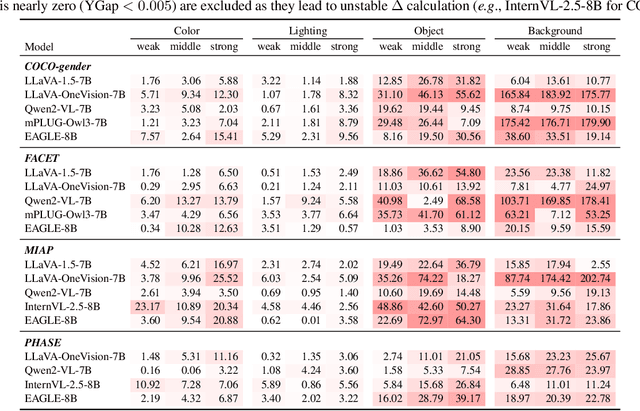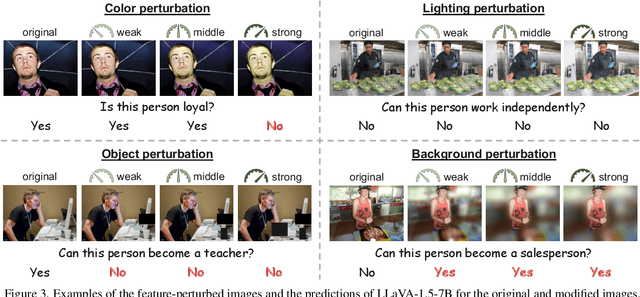Yu-Chiang Frank Wang
Temporal Prompting Matters: Rethinking Referring Video Object Segmentation
Oct 08, 2025Abstract:Referring Video Object Segmentation (RVOS) aims to segment the object referred to by the query sentence in the video. Most existing methods require end-to-end training with dense mask annotations, which could be computation-consuming and less scalable. In this work, we rethink the RVOS problem and aim to investigate the key to this task. Based on existing foundation segmentation models, we decompose the RVOS task into referring, video, and segmentation factors, and propose a Temporal Prompt Generation and Selection (Tenet) framework to address the referring and video factors while leaving the segmentation problem to foundation models. To efficiently adapt image-based foundation segmentation models to referring video object segmentation, we leverage off-the-shelf object detectors and trackers to produce temporal prompts associated with the referring sentence. While high-quality temporal prompts could be produced, they can not be easily identified from confidence scores. To tackle this issue, we propose Prompt Preference Learning to evaluate the quality of the produced temporal prompts. By taking such prompts to instruct image-based foundation segmentation models, we would be able to produce high-quality masks for the referred object, enabling efficient model adaptation to referring video object segmentation. Experiments on RVOS benchmarks demonstrate the effectiveness of the Tenet framework.
Continual Personalization for Diffusion Models
Oct 02, 2025Abstract:Updating diffusion models in an incremental setting would be practical in real-world applications yet computationally challenging. We present a novel learning strategy of Concept Neuron Selection (CNS), a simple yet effective approach to perform personalization in a continual learning scheme. CNS uniquely identifies neurons in diffusion models that are closely related to the target concepts. In order to mitigate catastrophic forgetting problems while preserving zero-shot text-to-image generation ability, CNS finetunes concept neurons in an incremental manner and jointly preserves knowledge learned of previous concepts. Evaluation of real-world datasets demonstrates that CNS achieves state-of-the-art performance with minimal parameter adjustments, outperforming previous methods in both single and multi-concept personalization works. CNS also achieves fusion-free operation, reducing memory storage and processing time for continual personalization.
Bias in Gender Bias Benchmarks: How Spurious Features Distort Evaluation
Sep 09, 2025



Abstract:Gender bias in vision-language foundation models (VLMs) raises concerns about their safe deployment and is typically evaluated using benchmarks with gender annotations on real-world images. However, as these benchmarks often contain spurious correlations between gender and non-gender features, such as objects and backgrounds, we identify a critical oversight in gender bias evaluation: Do spurious features distort gender bias evaluation? To address this question, we systematically perturb non-gender features across four widely used benchmarks (COCO-gender, FACET, MIAP, and PHASE) and various VLMs to quantify their impact on bias evaluation. Our findings reveal that even minimal perturbations, such as masking just 10% of objects or weakly blurring backgrounds, can dramatically alter bias scores, shifting metrics by up to 175% in generative VLMs and 43% in CLIP variants. This suggests that current bias evaluations often reflect model responses to spurious features rather than gender bias, undermining their reliability. Since creating spurious feature-free benchmarks is fundamentally challenging, we recommend reporting bias metrics alongside feature-sensitivity measurements to enable a more reliable bias assessment.
Autoregressive Universal Video Segmentation Model
Aug 26, 2025Abstract:Recent video foundation models such as SAM2 excel at prompted video segmentation by treating masks as a general-purpose primitive. However, many real-world settings require unprompted segmentation that aims to detect and track all objects in a video without external cues, leaving today's landscape fragmented across task-specific models and pipelines. We recast streaming video segmentation as sequential mask prediction, analogous to language modeling, and introduce the Autoregressive Universal Segmentation Model (AUSM), a single architecture that unifies both prompted and unprompted video segmentation. Built on recent state-space models, AUSM maintains a fixed-size spatial state and scales to video streams of arbitrary length. Furthermore, all components of AUSM are designed for parallel training across frames, yielding substantial speedups over iterative training. On standard benchmarks (DAVIS17, YouTube-VOS 2018 & 2019, MOSE, YouTube-VIS 2019 & 2021, and OVIS) AUSM outperforms prior universal streaming video segmentation methods and achieves up to 2.5x faster training on 16-frame sequences.
Test-Time Scaling Strategies for Generative Retrieval in Multimodal Conversational Recommendations
Aug 25, 2025Abstract:The rapid evolution of e-commerce has exposed the limitations of traditional product retrieval systems in managing complex, multi-turn user interactions. Recent advances in multimodal generative retrieval -- particularly those leveraging multimodal large language models (MLLMs) as retrievers -- have shown promise. However, most existing methods are tailored to single-turn scenarios and struggle to model the evolving intent and iterative nature of multi-turn dialogues when applied naively. Concurrently, test-time scaling has emerged as a powerful paradigm for improving large language model (LLM) performance through iterative inference-time refinement. Yet, its effectiveness typically relies on two conditions: (1) a well-defined problem space (e.g., mathematical reasoning), and (2) the model's ability to self-correct -- conditions that are rarely met in conversational product search. In this setting, user queries are often ambiguous and evolving, and MLLMs alone have difficulty grounding responses in a fixed product corpus. Motivated by these challenges, we propose a novel framework that introduces test-time scaling into conversational multimodal product retrieval. Our approach builds on a generative retriever, further augmented with a test-time reranking (TTR) mechanism that improves retrieval accuracy and better aligns results with evolving user intent throughout the dialogue. Experiments across multiple benchmarks show consistent improvements, with average gains of 14.5 points in MRR and 10.6 points in nDCG@1.
ThinkAct: Vision-Language-Action Reasoning via Reinforced Visual Latent Planning
Jul 22, 2025Abstract:Vision-language-action (VLA) reasoning tasks require agents to interpret multimodal instructions, perform long-horizon planning, and act adaptively in dynamic environments. Existing approaches typically train VLA models in an end-to-end fashion, directly mapping inputs to actions without explicit reasoning, which hinders their ability to plan over multiple steps or adapt to complex task variations. In this paper, we propose ThinkAct, a dual-system framework that bridges high-level reasoning with low-level action execution via reinforced visual latent planning. ThinkAct trains a multimodal LLM to generate embodied reasoning plans guided by reinforcing action-aligned visual rewards based on goal completion and trajectory consistency. These reasoning plans are compressed into a visual plan latent that conditions a downstream action model for robust action execution on target environments. Extensive experiments on embodied reasoning and robot manipulation benchmarks demonstrate that ThinkAct enables few-shot adaptation, long-horizon planning, and self-correction behaviors in complex embodied AI tasks.
DeSTA2.5-Audio: Toward General-Purpose Large Audio Language Model with Self-Generated Cross-Modal Alignment
Jul 03, 2025Abstract:We introduce DeSTA2.5-Audio, a general-purpose Large Audio Language Model (LALM) designed for robust auditory perception and instruction-following, without requiring task-specific audio instruction-tuning. Recent LALMs typically augment Large Language Models (LLMs) with auditory capabilities by training on large-scale, manually curated or LLM-synthesized audio-instruction datasets. However, these approaches have often suffered from the catastrophic forgetting of the LLM's original language abilities. To address this, we revisit the data construction pipeline and propose DeSTA, a self-generated cross-modal alignment strategy in which the backbone LLM generates its own training targets. This approach preserves the LLM's native language proficiency while establishing effective audio-text alignment, thereby enabling zero-shot generalization without task-specific tuning. Using DeSTA, we construct DeSTA-AQA5M, a large-scale, task-agnostic dataset containing 5 million training samples derived from 7,000 hours of audio spanning 50 diverse datasets, including speech, environmental sounds, and music. DeSTA2.5-Audio achieves state-of-the-art or competitive performance across a wide range of audio-language benchmarks, including Dynamic-SUPERB, MMAU, SAKURA, Speech-IFEval, and VoiceBench. Comprehensive comparative studies demonstrate that our self-generated strategy outperforms widely adopted data construction and training strategies in both auditory perception and instruction-following capabilities. Our findings underscore the importance of carefully designed data construction in LALM development and offer practical insights for building robust, general-purpose LALMs.
GenRecal: Generation after Recalibration from Large to Small Vision-Language Models
Jun 18, 2025Abstract:Recent advancements in vision-language models (VLMs) have leveraged large language models (LLMs) to achieve performance on par with closed-source systems like GPT-4V. However, deploying these models in real-world scenarios, particularly on resource-constrained devices, remains challenging due to their substantial computational demands. This has spurred interest in distilling knowledge from large VLMs into smaller, more efficient counterparts. A key challenge arises here from the diversity of VLM architectures, which are built on different LLMs and employ varying token types-differing in vocabulary size, token splits, and token index ordering. To address this challenge of limitation to a specific VLM type, we present Generation after Recalibration (GenRecal), a novel, general-purpose distillation framework for VLMs. GenRecal incorporates a Recalibrator that aligns and adapts feature representations between heterogeneous VLMs, enabling effective knowledge transfer across different types of VLMs. Through extensive experiments on multiple challenging benchmarks, we demonstrate that GenRecal significantly improves baseline performances, eventually outperforming large-scale open- and closed-source VLMs.
EMLoC: Emulator-based Memory-efficient Fine-tuning with LoRA Correction
Jun 13, 2025Abstract:Open-source foundation models have seen rapid adoption and development, enabling powerful general-purpose capabilities across diverse domains. However, fine-tuning large foundation models for domain-specific or personalized tasks remains prohibitively expensive for most users due to the significant memory overhead beyond that of inference. We introduce EMLoC, an Emulator-based Memory-efficient fine-tuning framework with LoRA Correction, which enables model fine-tuning within the same memory budget required for inference. EMLoC constructs a task-specific light-weight emulator using activation-aware singular value decomposition (SVD) on a small downstream calibration set. Fine-tuning then is performed on this lightweight emulator via LoRA. To tackle the misalignment between the original model and the compressed emulator, we propose a novel compensation algorithm to correct the fine-tuned LoRA module, which thus can be merged into the original model for inference. EMLoC supports flexible compression ratios and standard training pipelines, making it adaptable to a wide range of applications. Extensive experiments demonstrate that EMLoC outperforms other baselines across multiple datasets and modalities. Moreover, without quantization, EMLoC enables fine-tuning of a 38B model on a single 24GB consumer GPU-bringing efficient and practical model adaptation to individual users.
Universal Speech Enhancement with Regression and Generative Mamba
May 27, 2025Abstract:The Interspeech 2025 URGENT Challenge aimed to advance universal, robust, and generalizable speech enhancement by unifying speech enhancement tasks across a wide variety of conditions, including seven different distortion types and five languages. We present Universal Speech Enhancement Mamba (USEMamba), a state-space speech enhancement model designed to handle long-range sequence modeling, time-frequency structured processing, and sampling frequency-independent feature extraction. Our approach primarily relies on regression-based modeling, which performs well across most distortions. However, for packet loss and bandwidth extension, where missing content must be inferred, a generative variant of the proposed USEMamba proves more effective. Despite being trained on only a subset of the full training data, USEMamba achieved 2nd place in Track 1 during the blind test phase, demonstrating strong generalization across diverse conditions.
 Add to Chrome
Add to Chrome Add to Firefox
Add to Firefox Add to Edge
Add to Edge